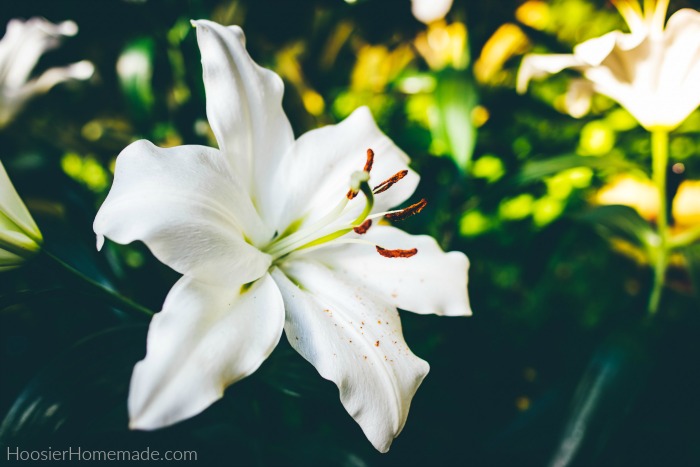Easter Lily Care

Spring is my favorite season, to me, it symbolizes renewal, regrowth and in some instances rebirth. And Easter lilies carry that meaning for many people as well. Here are some Easter lily care tips to make your plants last longer.

Photo Credit
The Easter lily has gained popularity over the years for its’ fragrant pristine white flowers with some plants supporting 5-6 blooms on 2 to 3-foot tall stalks.
The Easter lily, Lilium longiflorum, originates in Taiwan and the Ryukyu Islands. You may also come across Lilium formosana, a closely related species from Taiwan.
After reading this you will be versed in the care, re-potting and even history of Easter lilies.
Tips for choosing the best Easter lily
In order to get the most out of your plant, choose your potted plant wisely.
- Choose a plant with bulbs that have not completely opened. Look for a tight bulb to a partially opened flower.
- Look for plants with leaves and flower stalks that are dense and evenly green all the way down to the soil line.
- Check for disease by looking for crinkled or wilting leaves. Also, avoid plants with dark or light spots on the leaves.
- Look for insects, you don’t want unwanted guests in your house. Look for evidence of insect eggs, webbing and live insects on the plant.
Caring for your Easter lily indoors
When you bring your Easter Lily home from the store follow these steps to care for your potted Easter Lily and get the maximum bloom time out of your plant.
- Remove the decorative foil packaging that many potted lilies come in, as this can allow too much water to accumulate in the pot causing the roots to rot.
- Find a spot with bright, indirect light for your plant to grow. Too much direct light can overheat your lily and shorten their lifespan.
- Let your lily grow in an area that is free of any drafts. Protect it from heat vents.
- Easter lilies prefer indoor temperatures falling between 60 and 80 degrees Fahrenheit.
- Avoid over-watering and do not allow the pot to sit in water as this will promote root rot. Water only when the soil is dry to the touch.
- Remove the antlers, the yellow centers when the flowers open. This can extend the bloom time of the flowers along with preventing the bright yellow pollen from staining the otherwise white petals.
- Remove withering flowers. Once a flower begins to fade, pinch off the flower at the base of the petiole. This will help promote new flowers to emerge.

What to do when you Easter lily is no longer blooming
Once your lily is no longer blooming you can choose to transplant it into your garden or landscape.
Continue to water and follow these steps once the danger of frost in your area has passed to enjoy your Easter lily for many years.
- Remove all of the spent flowers and any dead or dying foliage at the soil line.
- Choose a spot outdoors that has soil that is somewhat rich and well-drained and in full sun.
- Plant the lily bulb to the same depth as it was in the container.
- Work bulb fertilizer or blood meal into the surface of the soil and water.
- Place mulch at a minimum of 2 inches in depth around the bulb but not directly contacting the base of the plant.
- At the end of the growing season cover with a thick layer of mulch to protect from the winter cold.
- Pull back the mulch in the spring as the weather warms
Be patient as most Easter lilies will not re-bloom until the year after they are transplanted. But the anticipation is worth it when these lilies brighten your late spring/early summer landscape.
Easter lily meaning and symbolism
According to Greek mythology, Easter lilies are said to have sprung from the mother’s milk that fell from Hera, the goddess of women and marriage.
And in Christianity, they are used as a symbol of the resurrection of Christ. And during Easter are used to adorn the church sanctuary.
Across religions, these plants with white flowers symbolize purity and grace.
Lilies and your pets
While lilies are some of the easiest and most beautiful plants for the landscape and garden. They are also one of the deadliest to your pet. Always keep cats and dogs away from your Easter lily indoors.
Keep your lily plants away from cats, if they should eat any part of the plant get them treated immediately. Even a small amount can make your cat sick if left untreated.
And dogs won’t fare much better. The bulb or tuber are the most toxic to dogs so if you have a pet that likes to dig keep an eye on them if you see any evidence of digging in the area where you plant your lilies.





